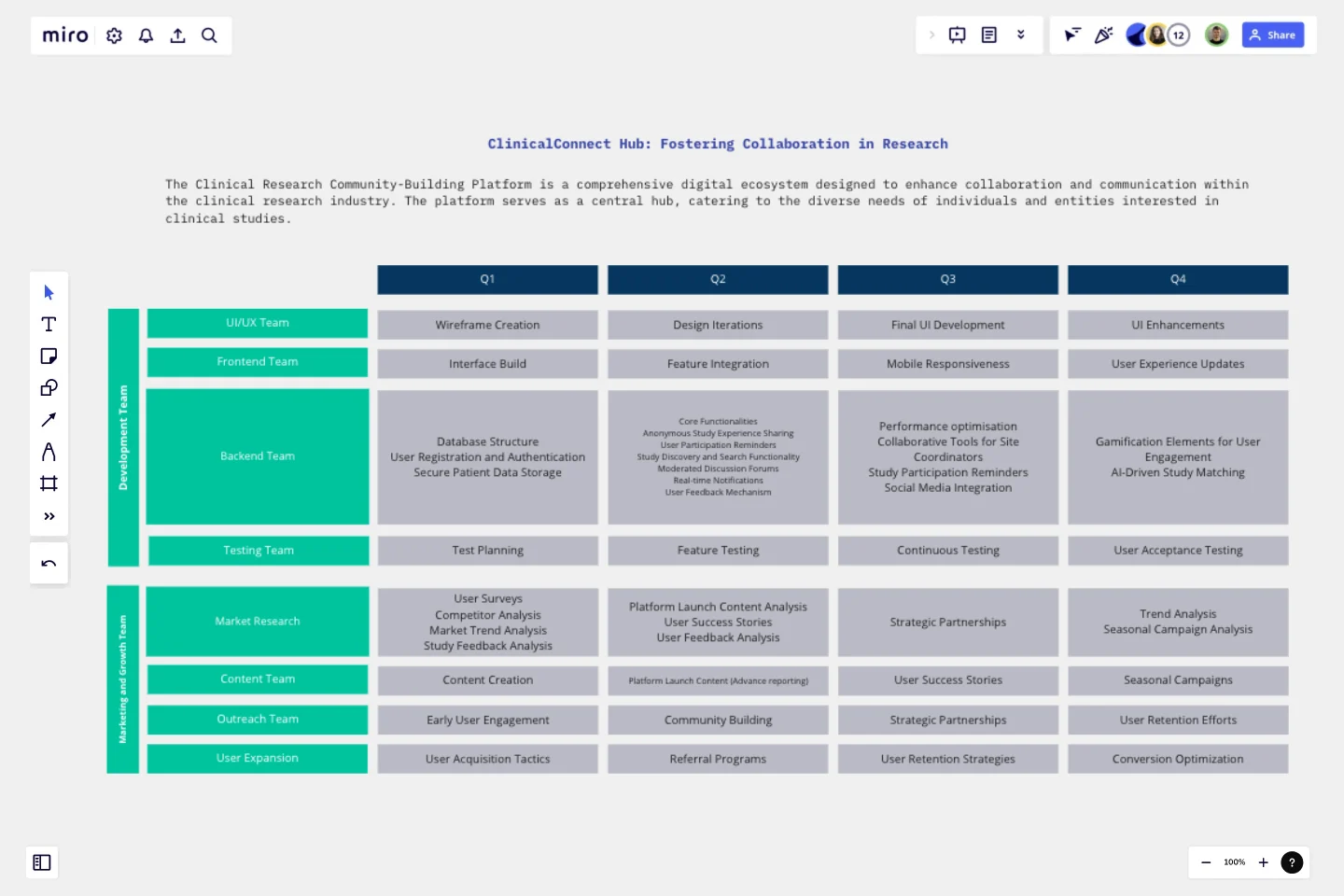Product Roadmap by Sahithi Alluru
This roadmap lays out the key steps and plans for different teams, such as design, development, testing, and marketing, for the quarters (Q1, Q2, Q3, Q4).
It helps us coordinate efforts, ensuring everyone works together towards the same goal. The roadmap includes essential features like user registration, secure data storage, and study discovery in must-have categories. It also outlines other features such as user feedback mechanisms and mobile responsiveness. This roadmap benefits our entire team, from developers to marketers, and helps us stay focused on creating a successful platform step by step.
Instructions to use the board
This board is designed to provide insights into the key stages of user engagement and business growth using the AARRR framework: Acquisition, Activation, Retention, Revenue, and Referral. Below are the instructions to navigate and utilize the board effectively:
Acquisition:
Explore the "Acquisition" section to understand marketing strategies and initiatives to increase brand visibility.
Look for conversion metrics related to platform visits and user registrations.
Activation:
Navigate to the "Activation" section to discover advertising and PR efforts leading to user sign-ups.
Examine conversion metrics focusing on the percentage of first-time users.
Retention:
Move to the "Retention" section to understand user communication strategies and encourage long-term engagement.
Evaluate the conversion metric for maintaining a high percentage of active users.
Revenue:
Examine the "Revenue" section to understand sales strategies and subscription-based revenue models.
Review conversion metrics associated with the monetary value of each subscription.
Referral:
Visit the "Referral" section to explore referral programs and initiatives driving user recommendations.
Analyze conversion metrics related to friends invited through referrals.
This template was created by Sahithi Alluru.
Get started with this template right now.
Cone Roadmap
Works best for:
Roadmap, Planning, Mapping
The Cone Roadmap template offers a visual representation of project timelines and dependencies, with a focus on narrowing scope over time. By starting with broad initiatives and gradually refining them into actionable tasks, teams can manage complexity and ensure alignment with strategic goals. This template promotes transparency and adaptability, empowering teams to respond effectively to changing priorities and market dynamics.
Cynefin Framework Template
Works best for:
Leadership, Decision Making, Prioritization
Companies face a range of complex problems. At times, these problems leave the decision makers unsure where to even begin or what questions to ask. The Cynefin Framework, developed by Dave Snowden at IBM in 1999, can help you navigate those problems and find the appropriate response. Many organizations use this powerful, flexible framework to aid them during product development, marketing plans, and organizational strategy, or when faced with a crisis. This template is also ideal for training new hires on how to react to such an event.
Agile Product Roadmap by HatchWorks
Works best for:
Product Management, Roadmap
Enhance your agile workflow with the Agile Product Roadmap by HatchWorks. This template helps you plan and track product development in agile sprints, ensuring continuous delivery and improvement. Use it to align teams, prioritize features, and adapt quickly to changes. Ideal for agile teams aiming to maintain flexibility and efficiency in their product development process, ensuring timely and iterative delivery of enhancements.
Software Requirements Document
Works best for:
Product Development, Software Development
Unlock unmatched project clarity and effortlessly manage your software project requirements with Miro's Software Requirements Document Template. This template helps you empower your team by visually representing your project's scope, including functional and non-functional requirements. With dynamic flowchart features, you can effortlessly expand and refine your project details, ensuring a shared understanding among team members.
Timeline Design
Works best for:
Timeline, Planning
The Timeline Design template is perfect for creating visually engaging timelines. It helps you showcase project milestones, deadlines, and important events in a clear and attractive format. Ideal for presentations and reports, this template ensures your timeline is both informative and visually appealing.
Fishbone Diagram by Dave Westgarth
Works best for:
Fishbone diagram
Identify and solve problems effectively with the Fishbone Diagram by Dave Westgarth. This template helps you break down complex issues into root causes, enabling a thorough analysis and targeted solutions. Use it for quality control, process improvement, and troubleshooting in various industries. Ideal for teams focused on continuous improvement and problem-solving.
